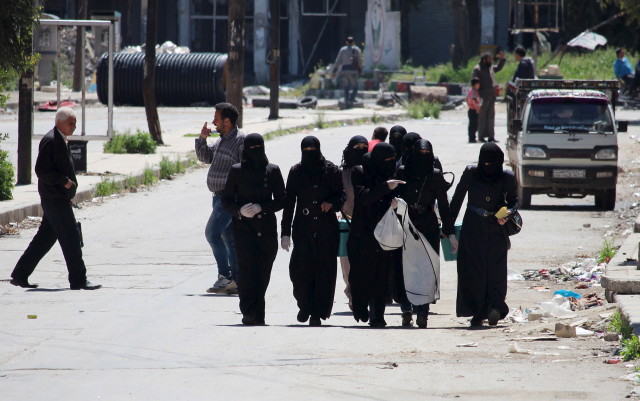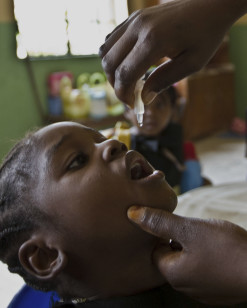Posted October 23rd, 2015 at 9:20 am (UTC-4)
By Dr. Tom Frieden, Director, Centers for Disease Control and Prevention 
Today, on World Polio Day, we honor the sacrifices of the many people around the world who have brought us to a unique point in history: the brink of polio elimination.
Thanks to more than two decades of relentless work by local, national and international partners, the number of people with a direct and tragic connection to polio has declined sharply. It has not been so very long since communities everywhere were all too familiar with the sight of children with disfigured limbs from polio. Few of today’s doctors and nurses have treated a case of polio, and few families now experience the tragedy of having a child disabled by the disease.

Female medical nurse activists tour the streets of Aleppo’s rebel-controlled areas during a polio vaccine campaign. April 13, 2015. (REUTERS)
Much of our recent progress against polio is due to the commitment and courage of the polio vaccinators who work tirelessly, often in remote and dangerous areas, to eradicate this disease. Some of these dedicated individuals have lost their lives in the struggle to create a brighter future for the world’s children.
World Polio Day is particularly important this year. We’re tantalizingly close to eradicating polio – but we are not there yet. Today is a good day to recognize our successes, reaffirm our commitment, and take stock of what’s needed to reach the ultimate goal of ending polio once and for all.
On October 2, 2015, Nigeria was removed from the list of polio-endemic countries. Since Nigeria was the last holdout where wild poliovirus could be found in Africa, this achievement is a key milestone to certifying the entire Africa region polio-free in the next two years.

A volunteer health official immunizes a child against polio at a school in Nigeria’s capital Abuja February 1, 2010. (REUTERS)
Success in Nigeria gives even more hope and incentive to the final two countries with circulating wild poliovirus – Pakistan and Afghanistan. The government of Pakistan has reaffirmed its commitment to ending polio and is intensifying vaccination efforts. Afghanistan continues to have persistent low-level transmission of polio, but is enhancing its polio detection capabilities and working to reach children in previously inaccessible areas. The heroic efforts of Pakistani and Afghan health workers are an inspiration.
This intensive global polio eradication effort has resulted in the lowest number of cases in history – just 48 cases so far this year. Since 1988 more than 2.5 billion children have been vaccinated, preventing at least 10 million children from becoming paralyzed for life. But until polio is wiped out everywhere, all children remain at risk.
We are committed to overcoming the final obstacles to eradicating polio forever and ensuring that children everywhere live free from this terrible disease. To end polio forever, all countries must strengthen vaccine service delivery, address gaps in disease surveillance and do more to reach children missed by vaccination programs.
So today, World Polio Day 2015, let us remember the sacrifice, hard work, and international cooperation that got us to the point where we can see the end of polio. Let us recommit ourselves to doing whatever is needed, wherever needed, to create a polio-free legacy not only for our children – but for all future generations.
World Polio Day: How Far We’ve Come, What’s Left to Do
By Dr. Tom Frieden, Director, Centers for Disease Control and Prevention
Today, on World Polio Day, we honor the sacrifices of the many people around the world who have brought us to a unique point in history: the brink of polio elimination.
Thanks to more than two decades of relentless work by local, national and international partners, the number of people with a direct and tragic connection to polio has declined sharply. It has not been so very long since communities everywhere were all too familiar with the sight of children with disfigured limbs from polio. Few of today’s doctors and nurses have treated a case of polio, and few families now experience the tragedy of having a child disabled by the disease.
Female medical nurse activists tour the streets of Aleppo’s rebel-controlled areas during a polio vaccine campaign. April 13, 2015. (REUTERS)
Much of our recent progress against polio is due to the commitment and courage of the polio vaccinators who work tirelessly, often in remote and dangerous areas, to eradicate this disease. Some of these dedicated individuals have lost their lives in the struggle to create a brighter future for the world’s children.
World Polio Day is particularly important this year. We’re tantalizingly close to eradicating polio – but we are not there yet. Today is a good day to recognize our successes, reaffirm our commitment, and take stock of what’s needed to reach the ultimate goal of ending polio once and for all.
On October 2, 2015, Nigeria was removed from the list of polio-endemic countries. Since Nigeria was the last holdout where wild poliovirus could be found in Africa, this achievement is a key milestone to certifying the entire Africa region polio-free in the next two years.
A volunteer health official immunizes a child against polio at a school in Nigeria’s capital Abuja February 1, 2010. (REUTERS)
Success in Nigeria gives even more hope and incentive to the final two countries with circulating wild poliovirus – Pakistan and Afghanistan. The government of Pakistan has reaffirmed its commitment to ending polio and is intensifying vaccination efforts. Afghanistan continues to have persistent low-level transmission of polio, but is enhancing its polio detection capabilities and working to reach children in previously inaccessible areas. The heroic efforts of Pakistani and Afghan health workers are an inspiration.
This intensive global polio eradication effort has resulted in the lowest number of cases in history – just 48 cases so far this year. Since 1988 more than 2.5 billion children have been vaccinated, preventing at least 10 million children from becoming paralyzed for life. But until polio is wiped out everywhere, all children remain at risk.
We are committed to overcoming the final obstacles to eradicating polio forever and ensuring that children everywhere live free from this terrible disease. To end polio forever, all countries must strengthen vaccine service delivery, address gaps in disease surveillance and do more to reach children missed by vaccination programs.
So today, World Polio Day 2015, let us remember the sacrifice, hard work, and international cooperation that got us to the point where we can see the end of polio. Let us recommit ourselves to doing whatever is needed, wherever needed, to create a polio-free legacy not only for our children – but for all future generations.